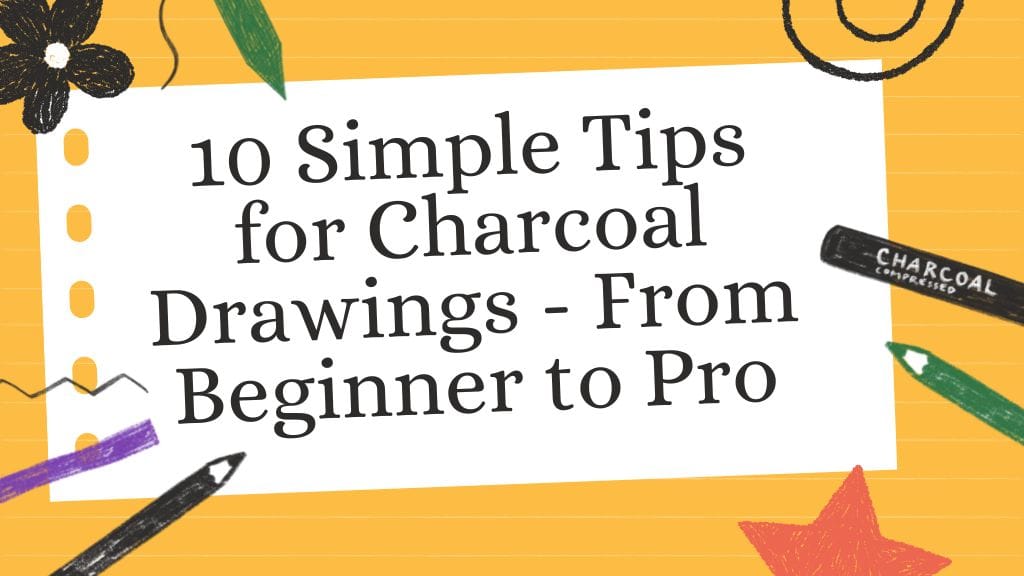Tips for charcoal drawing is a timeless and captivating art form that allows artists to express their creativity and emotions in a unique and impactful way. Whether you’re a beginner or an experienced artist, mastering the art of charcoal drawings can be a rewarding journey.
In this article, we’ll delve into 10 easy tips for charcoal drawing that will help you create stunning charcoal artworks and elevate your skills to new heights. From understanding the basics to exploring advanced techniques, these tips will guide you towards achieving excellence in charcoal drawings.
1. Gather the Right Materials
Before you embark on your charcoal drawing journey, it’s essential to gather the right materials. Invest in high-quality charcoal pencils, sticks, and paper specifically designed for charcoal drawings. Opt for different grades of charcoal to achieve varying tones and effects. A kneaded eraser, blending stumps, and fixative spray are also indispensable tools for refining your drawings.
2. Understand Value and Contrast
To create visually striking charcoal drawings, focus on achieving strong contrasts between light and shadow. Experiment with different pressures and techniques to control the density of your charcoal marks. This will allow you to create depth and dimension in your drawings, making them more captivating and realistic.
3. Start with Simple Subjects
For beginners, it’s advisable to start with simple subjects before progressing to more complex compositions. Begin with basic shapes, objects, or even simple still life setups. This approach will help you grasp the fundamental techniques of charcoal drawing without feeling overwhelmed. As you gain confidence, gradually challenge yourself with more intricate subjects.
4. Master the Art of Blending
Blending is a crucial technique in charcoal drawings, as it helps soften harsh lines and transitions. Use blending stumps, your fingers, or even soft brushes to gently smudge and merge charcoal marks. This technique is particularly effective for creating smooth transitions in areas such as skin tones and gradients.
5. Explore Different Textures
Charcoal is a versatile medium that allows you to create a wide range of textures, from smooth surfaces to rough textures. Experiment with different drawing surfaces and techniques to achieve diverse effects. For example, you can use cross-hatching for a textured appearance, or scumbling for a softer, atmospheric effect. Incorporating various textures will add visual interest to your artwork.
6. Embrace Negative Space
Negative space refers to the area around your subject. Paying attention to negative space can greatly enhance the composition of your charcoal drawings. Use it strategically to balance the elements within your artwork and create a sense of harmony. This technique will help guide the viewer’s eye and make your drawings more visually pleasing.
7. Work from General to Specific
When approaching a charcoal drawing, start by outlining the general shapes and proportions before moving into finer details. This approach will help you establish a solid foundation for your artwork and prevent mistakes that are difficult to correct later on. Gradually build up the details as you gain confidence in the accuracy of your initial sketch.
8. Experiment with Different Paper Tones
The tone of the paper you choose can significantly influence the mood and impact of your charcoal drawings. Experiment with both white and toned papers to discover how they affect the overall appearance of your artwork. Toned papers can add warmth and depth to your drawings, while white papers allow for a broader range of highlights.
9. Use Reference Images Wisely
Reference images are invaluable tools for artists, providing guidance and inspiration. However, it’s crucial to use them wisely. Avoid copying a reference image entirely; instead, use it as a foundation to create your interpretation. This will ensure that your artwork retains your unique artistic style and perspective.
10. Practice Regularly and Patience
As with any art form, practice is key to mastering charcoal drawings. Set aside dedicated time for regular practice sessions, allowing yourself to experiment, learn, and grow. Be patient with yourself, as charcoal drawing is a skill that takes time to develop.
Charcoal drawings have a timeless appeal that continues to captivate artists and viewers alike. By following these 10 easy tips, you can embark on a journey to master the art of charcoal drawing. Remember that every artist’s journey is unique, so don’t be afraid to experiment, make mistakes, and develop your own style along the way.
With the right materials, techniques, and dedication, you can create stunning charcoal artworks that leave a lasting impression. Start your charcoal drawing adventure today and watch as your skills flourish through practice, creativity, and a passion for the craft.
